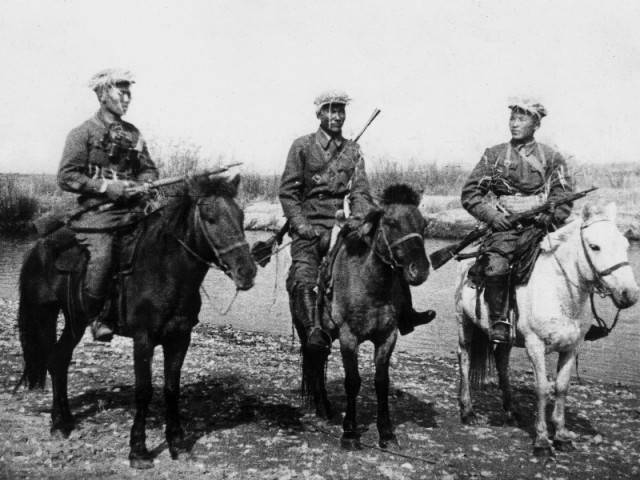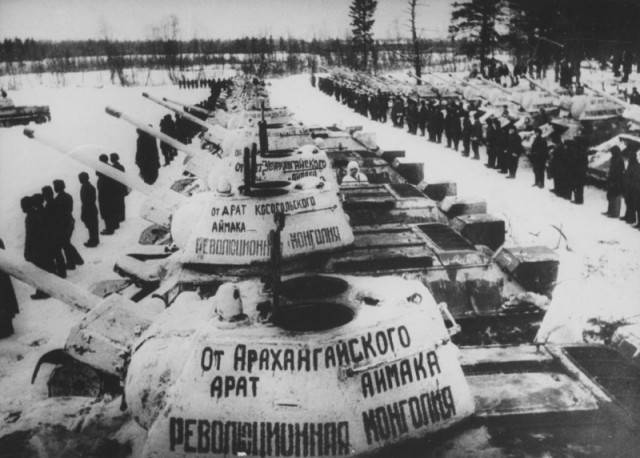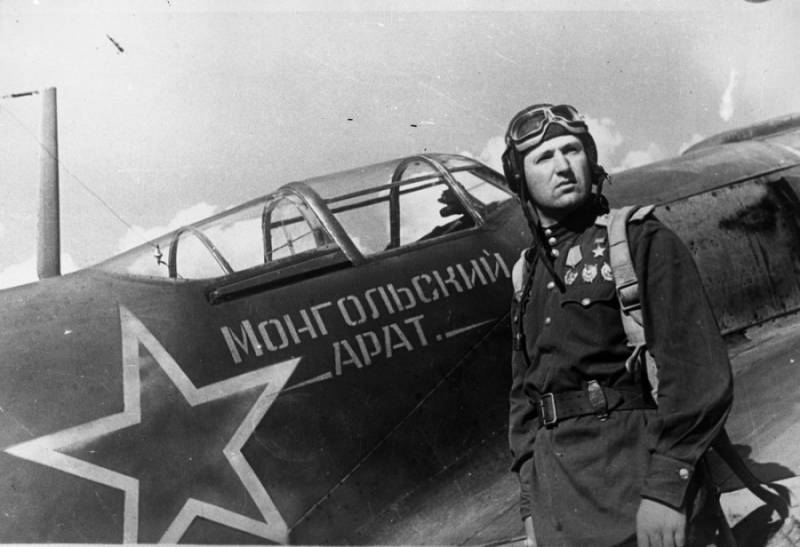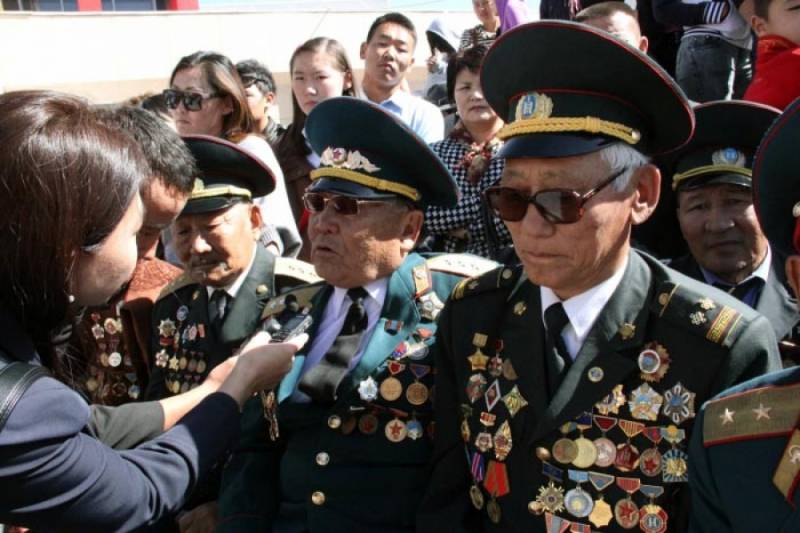How Mongolia helped beat Hitler
Mongolia, and Tuva to the beginning of the 1940-ies. They were economically underdeveloped and sparsely populated countries that received great help from the Soviet Union and were themselves far from in a better situation. But they were the first to side with the USSR. 22 June 1941 of the year X The Great Khural of the Tuva People’s Republic unanimously adopted the Declaration of the full support of the Soviet Union. Tuva was the first foreign state to enter the war on the side of the Soviet Union. 25 June 1941, the Tuvan People's Republic declared war on Hitler Germany.
22 June 1941 held a meeting of the Presidium of the People’s Khural and the Central Committee of the Mongolian People’s Revolutionary Party, at which the leadership of the MPR made the unequivocal decision to assist the Soviet Union in the fight against German Nazism. In September, the Central Committee for Assistance to the Red Army was established by the Mongolian People’s Government 1941, and its local units appeared in each city, aimag and somone of Mongolia. The work of the commissions involved government officials, party and youth activists. But the main role in collecting aid, of course, was played by the most ordinary citizens of Mongolia - simple working people.
Throughout the war, Mongolia sent horses to the front, food, paid for the construction tanks and airplanes. Her help was tremendous, despite the limited capabilities of the country. First of all, Mongolia helped the Soviet Union with the products of its agriculture, the main branch of the country's economy. Mongolia transferred to the Soviet Union 500 thousand Mongolian horses, distinguished by strength, endurance and unpretentiousness. Another 32 thousand horses were donated by the Mongolian arats - pastoralists as donations. Mongolian horses were actively used as draft power, especially for the needs of artillery units. The excellent qualities of the Mongolian horses were noted, in particular, by General Issa Pliev, who emphasized that the unpretentious Mongolian horse, along with Soviet tanks, reached Berlin in the spring of 1945. In fact, every fifth horse that participated in the war as part of the Red Army was transferred to the Soviet Union by Mongolia.

As early as October 1941, the first echelon of food and clothing — soldier belts, woolen sweaters, sheepskin coats, fur vests, gloves and mittens, and blankets — went to the Soviet Union. A delegation of Mongolian workers arrived in the USSR along with a train headed by Deputy Prime Minister of the MPR Lubsan and Secretary of the Central Committee of the Mongolian People's Republic Sukhbataryn Yanzhmaa (widow of the Mongolian revolution leader Suhe Bator). The Mongolian delegation was accepted by the command of the Western Front, visited the location of units and divisions.
In just four years of the Great Patriotic War, Mongolia transferred to the Soviet Union, in addition to horses, 700 thousand cattle heads, 4,9 million heads of small cattle. Mongolian aid made a great contribution to the food and clothing support of the Red Army - almost 500 thousand tons of meat, 64 thousand tons of wool, 6 million pieces of small leather raw materials were supplied to the USSR. Of course, the Soviet Union paid for Mongolia with the supply of other goods, but in general, the help of the steppe neighbors was very significant. For example, it was Mongolia that was the main supplier of sheepskin, from which officers made fur coats for the needs of the commanders of the Red Army. Overcoats for soldiers and sergeants of the Red Army were made of Mongol wool.
After the calculations, it turned out that small Mongolia supplied wool and meat to the Soviet Union during the war years more than the United States of America. If we talk, for example, about the supply of wool, then from the United States during the war years 54 were delivered thousand tons of wool, and from Mongolia - 64 thousand tons of wool. This is a very impressive difference, given the huge gap between the United States and Mongolia, both in the territory, in the population, and in the resource possibilities. When they now say that without the American assistance the USSR would be much more difficult to win the war, they forget about the disparity between the scale of American Lend-Lease and the Mongolian supplies. If Mongolia had the scale and capabilities of the United States, it is possible that Hitler would have been defeated in the first months of the war.
Dozens of trains from Mongolia went to the Soviet Union. 30 115 30 500 FUR COATS Jam, 31 tons of sausage, 257 tons of oil - this is a list of the contents of only one of the trains coming from Mongolia to the Soviet Union. Ordinary Mongols - herders, workers, employees - collected money for arming the Soviet units, sent food, hand-made sweaters or mittens. The collection of aid to the Red Army was centralized and was organized by the Mongolian government.

Mongolia helped the USSR not only with food and clothing. A fundraising campaign was organized for the Red Army. As early as January 1942, the session of the Small Khural of the Mongolian People's Republic decided to purchase the Revolutionary Mongolia tank column through donations from Mongol arats, workers and employees. Fundraising was very active. By February, 1942, a large amount of funds were collected - 2,5 million Mongolian mire, 100 thousand US dollars and 300 kg of gold, which in total corresponded to 3,8 million Soviet rubles. The MPR donated this money to Vneshtorgbank of the USSR for the construction of a tank column. 12 On January 1943, a Mongolian government delegation led by Marshal Khorlogiy Choibalsan, who arrived in the Moscow Region, handed over the T-112 tank to the 32-th Red Banner Tank Brigade 34 command. The commander of the 21 Tank Brigade, Andrei Getman, also received a fur doha, donated by a teacher from Ulan Bator named Tserenglan. The 70-I tank brigade was renamed 112-th Guards Red Banner Tank Brigade "Revolutionary Mongolia". It is noteworthy that the Mongolian side took upon itself the full food and clothing provision for the tank brigade “Revolutionary Mongolia”.
The help of Mongolia to the Soviet Union did not stop on the tank column. A new fundraiser was organized - this time for the construction of the Mongolian Arat aircraft squadron. On July 22, 1943, the Prime Minister of the MPR Choibalsan informed Joseph Stalin that the MPR was transferring 2 million tugriks for the construction of 12 La-5 combat aircraft for aviation Squadron "Mongolian arat". On August 18, Stalin thanked the Mongolian leadership for their help, and on September 25, 1943, in the Smolensk region, at the field airfield of the Vyazovaya station, a solemn transfer of aircraft to the 2nd Guards Fighter Aviation Regiment of the 322nd Fighter Aviation Division took place. In addition to the transferred planes, Mongolia, according to the established tradition, took upon itself the task of providing food and clothing supplies to the Mongolian Arat squadron until the end of the war.
Of course, we should not forget that the control system in the MPR at that time was rigid, taking the example of the Soviet, and such a huge scale of assistance was the result of not only the fraternal outburst of the Mongols, but also the general mobilization nature of the Mongolian economy. It is known that domestic consumption of food and other goods has decreased in some regions of the MPR. And, nevertheless, many Mongols not only sent the products of their labor to the USSR, but also volunteered for the Red Army. During the Great Patriotic War, thousands of Mongolian volunteers fought as part of the Red Army. The Mongols served as snipers and scouts, fought as part of the cavalry units of the Red Army.
In the front row of Mongolians who left for the front were Russians - Soviet citizens living in the country. In the north of the country were 9 Russian villages, besides a significant number of Russian lived in Ulan Bator. 22 people left the 5000-thousandth Russian population of Mongolia, including women, old people and children, almost all men from 17 to 50 years. The military commissariat, through which the call-up for military service in the Red Army was carried out, was located in Ulan Bator. Approximately half of the Mongolian Russians did not return from the front, and there is no information about cases of desertion. Assistance to the families of Russians who went to the front from Mongolia was provided by the Mongolian People's Republic Government, which adopted for this purpose a special decree on the payment of benefits to the families of servicemen.
Attention should be paid to another side of the Mongolian aid to the Soviet Union. It is known that due to the constant threat of attack by Japan on the Far East, the Soviet leadership was forced to hold huge armed forces in the Far Eastern region of about a million military personnel. In this situation, Mongolia was the main ally of the USSR in the region, which, if anything, could assist in repelling the aggression of imperialist Japan. This was well understood by the Mongolian leadership, which increased the number of the Mongolian People’s Revolutionary Army four times and intensified the combat training of personnel, including the training of the Mongolian commanders in the Soviet military schools.
8 August 1945 g. The Soviet Union officially declared war on Japan. Two days later, on August 10 of 1945, the Mongolian People's Republic declared war on Japan. Parts of the INRA were to work together with the Red Army on the fronts of the Far East. In Mongolia, a general mobilization began, which, given the small population of the country, affected almost all men of Mongolia. Parts and formations of the INRA were incorporated into the Horse-mechanized group of the Trans-Baikal Front, commanded by Colonel-General Issa Alexandrovich Pliev.
Lieutenant-General Jamian Lhagvasuren became deputy commander for Mongolian troops, and the head of the political department of Mongolian forces was Lieutenant-General Yumzhagin Tsedenbal. The Pliyev group's Mongolian formations included the 5-I, 6-I, 7-I and 8-I Cavalry divisions of the MPRA, the 7-I motorized armored brigade of the MPRA, the 3-th separate tank regiment and the 29-th artillery regiment of the MNRA. In total, in the horse-mechanized formations of the INRA, there were 16 thousands of personnel, consolidated cavalry and 4 aviation divisions, a motor-armored brigade, a tank and artillery regiment, a communications regiment. Another 1 of thousands of Mongolian servicemen served in other units and formations on the front, while the rest of the forces were on the territory of the Mongolian People's Republic proper — in reserve and in rear work.
The Mongolian People’s Revolutionary Army took an active part in the Manchurian operation, losing about 10,000 dead people. 200 September 2 Japan signed an act of surrender. For Mongolia, Japan’s capitulation and the end of World War II were accompanied by a landmark event - the world officially recognized the independence of the Mongolian state, which was preceded by the consent of China, which had previously claimed to Outer Mongolia, to hold a referendum. 1945 October 20 d. 1945% Mongols voted for the political independence of Mongolia. True, China recognized the political sovereignty of the Mongolian People's Republic only four years later, after the Chinese Communists won the final victory in the civil war.
The memory of how the Soviet Union and Mongolia fought shoulder to shoulder, both countries still keep. For a long time, while veterans of the Great Patriotic War were alive and relatively young, solemn meetings were held for the veterans of the Revolutionary Mongolia tank column and the Mongolian Arat aviation squadron and the war veterans in Manchuria. Mongolian delegations take part in the celebration of the next anniversary of the Great Victory in Moscow. Speaking about the scale of foreign aid to the Soviet Union during the Great Patriotic War, in no case should we forget about the contribution that small Mongolia made to the victory over Nazi Germany.


Information